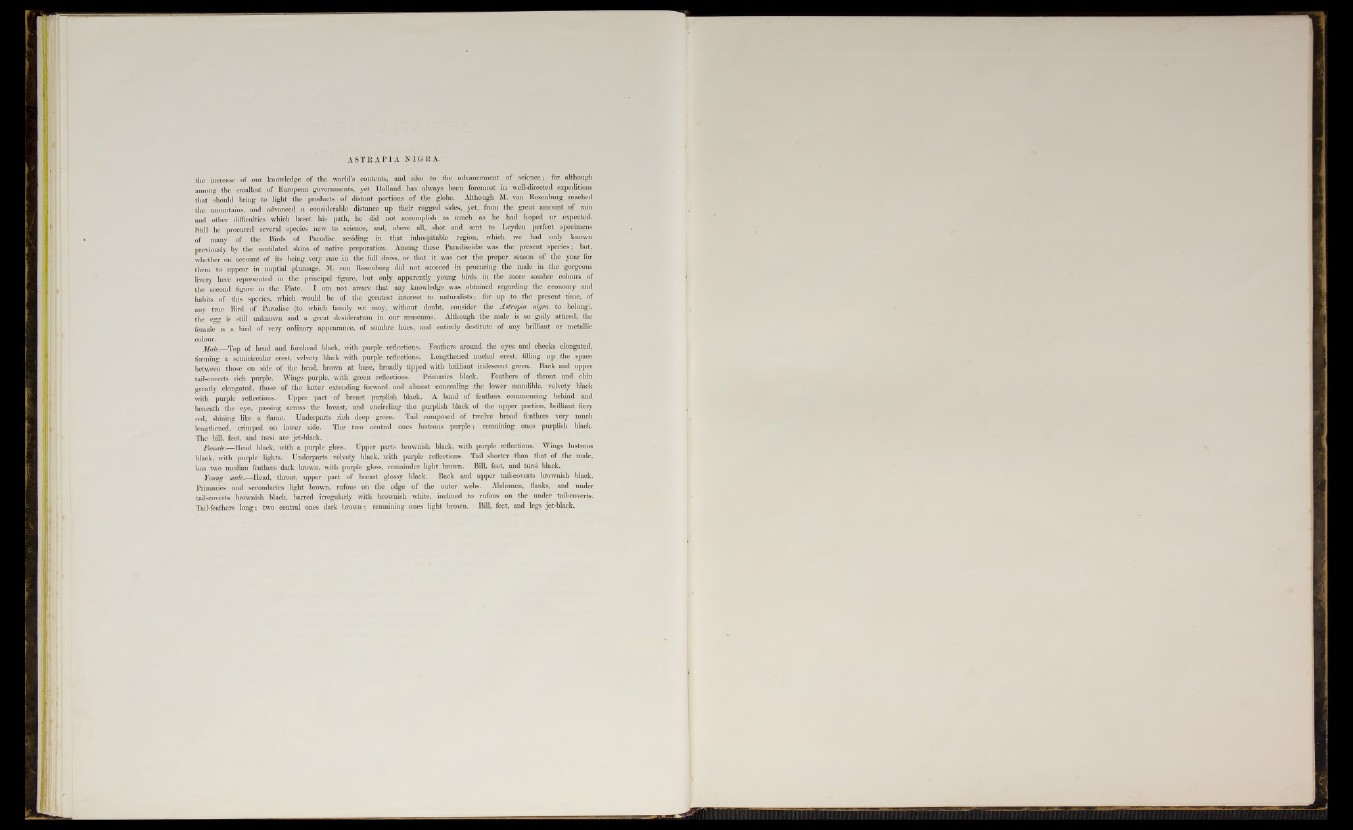
A S T R A P I A N IGRA .
the increase of our .knowledge of the world’s contents, and also to the advancement of science ; for although
among the smallest of European governments, yet Holland has always been foremost in well-directed expeditions
that should bring to light the products of distant portions of the globe. Although M. von Rosenburg reached
the mountains, and advanced a considerable distance up their rugged sides, yet, from the great amount of rain
and other difficulties which beset his path, he did not accomplish as much as he had hoped or expected.
Still he procured several species new to science, , and, above all, shot and sent to Leyden perfect specimens
of many of the Birds of Paradise residing in that inhospitable region, which we had only known
previously by the mutilated skins of native preparation. Among these Paradiseidse was the present species; but,
whether on account of its being very rare in the foil dress, or that it was not the proper season of the year for
them to appear in nuptial plumage, M. von Rosenburg did not succeed in procuring the male in the gorgeous
livery here represented in the principal figure, but only apparently young birds in the more sombre colours of
the second figure in the Plate. I am not aware that any knowledge was obtained regarding the economy and
habits of this species, which would be of the greatest interest to naturalists; for up ;to the present time, of
any true Bird of Paradise (to which family we may, without doubt, consider the Astrapia nigra to belong),
the egg is still unknown and a great desideratum in our museums.. Although ithe .male is so gaily attired, the
female is a bird of very ordinary appearance, of sombre hues, and entirely destitute of any brilliant or metallic
colour.
Male. Top of head and forehead black, with purple reflections. Feathers around the eyes and cheeks elongated,
forming a semicircular crest, velvety black with purple reflections. Lengthened nuchal crest, filling up the space
between those on side of the head, brown at base, broadly tipped with brilliant iridescent green. Back and upper
tail-coverts rich purple. Wings purple, with green reflections. Primaries black. Feathers of throat and chin
greatly elongated, those of the latter extending forward and almost concealing the lower mandible, velvety black
with purple reflections.1 Upper part of breast purplish black. A band of feathers commencing behind and
beneath the eye, passing across the breast, and encircling the purplish black of the upper portion, brilliant fiery
red,1 «Inning like a flame. Underparts rich deep green. Tail composed of twelve broad feathers very much
lengthened, crimped on lower side. The two central ones lustrous purple; remaining ones purplish black.
The bill, feet, and tarsi are jet-black.
Female.—Head black, with a purple gloss. Upper parts brownish black, with purple reflections. Wings lustrous
black, with purple lights. Underparts velvety black, with purple reflections. Tail shorter than that of the male,
has two median feathers dark brown, with purple gloss, remainder light brown. Bill, feet, and tarsi black.
Young male.—Head, throat, upper part of breast glossy black. Back and upper tail-coverts brownish black.
Primaries and secondaries light brown, rufous on the edge of the outer webs. Abdomen, flanks, and under
tail-coverts brownish black, barred irregularly with brownish white, inclined to rufous on the under tail-coverts.
Tail-feathers long; two central ones dark brown; remaining ones light brown. Bill, feet, and legs jet-black.